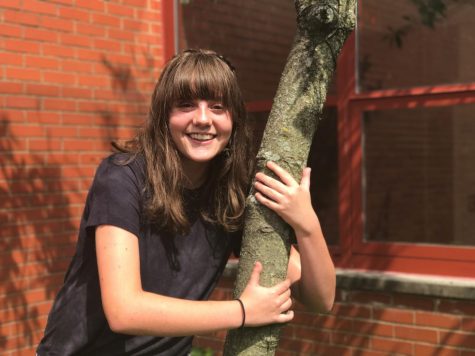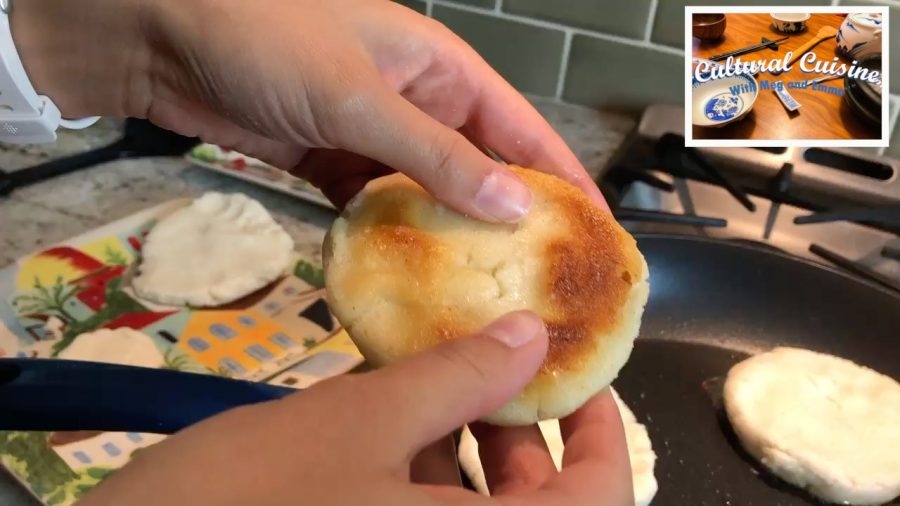Cultural Cuisine with Meg and Emma: Venezuelan Arepas
A column about exploring and celebrating different cultures through their unique food.
Emma Kim, Meg Patterson, and Almira Kusuma
Venezuelan Arepas
Welcome to the first video of Cultural Cuisine with Meg and Emma! If you are interested in making arepas, here are more in depth instructions:
- Ingredients/Materials:
- Big/medium sized bowl (a second one is optional)
- 2 cups of water
- 2 cups of P.A.N. (can be bought at Whole Foods)
- Pure Vegetable Oil (however much spreads throughout the entirety of the pan)
- A pinch of sea salt
- Pan and spatula
- Measure out 2 cups of P.A.N and put it into the big/medium bowl. You can either pour some of it into an additional bowl to scoop it out with a measuring cup, or directly take it from the package.
- Add the 2 cups of water to the big/medium bowl.
- Add the pinch of salt (style is optional).
- Mix it with your hands until it is completely meshed together.
- Form patty-like shapes and put them on a plate. Make sure to make the outside edges smooth and bent inward.
- Set your stove’s heat depending on how fast you want the arepas to cook. Put your pan on the stove and take out a second plate to place the cooked arepas on.
- Pour enough oil onto the pan so that it spreads throughout the entire pan.
- Pick up the uncooked arepas and put them, 3 at a time, on the pan.
- Keep checking the bottoms to see if they’re ready by slightly picking up one side to peek underneath. You want them to be golden brown, or slightly burnt.
- When the bottom side is done, flip them over to cook the other side. When the top is done too, put them on the plate for the cooked arepas.
- Put whatever you want inside!
Ana shared further details about the significance of arepas to her and her culture by answering some interview questions.
- How did you learn the recipe/who taught you?
“My mom has been making arepas for as long as I can remember. Because I watched her make them often since my early childhood, I learned by imitating her way of making them with repetition and practice.”
- How often do you make arepas?
“My mom and I normally make arepas every other weekend. In Venezuela, people make them as often as twice a week. This is because arepas are to Venezuelan culture as bread is to American culture.”
- Do you have any special day/memory that arepas were a part of?
“My family has made many good memories of preparing breakfast with arepas as the main dish. We all contribute to the preparation, and we all seem to embrace the glimpse of Venezuelan culture we get through the arepas that we often lack in the U.S.”
- What other foods/drinks do you usually have with arepas?
“It is typical to have shredded meat and black beans as sides for the arepas. However, my family usually has scrambled or fried eggs with them.”
- What does your idea of the perfect arepa look like?
“A perfect arepa would be rounded around the edges and have a golden-brown color. It would have a crust on the outside and a soft inside. They would be slightly thick and puffed up when they come out of the oven. They would contain enough salt in them to cancel out the flavor of the corn flour.”
- Besides arepas, are there any other significant cultural dishes that you would like to share?
“There are many other significant Venezuelan cultural dishes. Ones that my family makes on occasion are:
Cachapas (breakfast) – Venezuelan pancakes made with corn and sweet cream corn
Hallacas (dinner) – corn dough stuffed with vegetables and type of meat (beef, pork, chicken, etc.)”
- What is your all-time favorite Venezuelan dish?
“Tequeños are my favorite Venezuelan dish. They are sticks of fried pastry dough stuffed with cheese. They resemble American mozzarella sticks but, in my opinion, are ten times better.”
We hope that you enjoyed learning a bit about Venezuelan food culture with us, and hope to see you next time. Thank you Ana!

Grade: 10
Years on Staff: 1
Role: Staff Writer
Hobby/Sport/Clubs/Pastime: Piano, Field Hockey, Key Club, Duquesne English Festival, Sweets For Souls,...

Grade: 10
Years on staff: 2
Role: Staff Writer
Life soundtrack: (song) “Where is my Goat” by Taryn Southern
hobby/ sport/...








Jaime Martinez • Oct 11, 2018 at 7:04 pm
Yay Ana! Love love LOVEEE arepas!